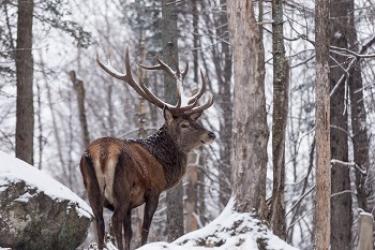Living with Elk
Like any wild species, particularly large mammals, elk needs and behavior can sometimes conflict with landowner goals. Elk are naturally drawn to shoots and young seedlings. They may browse or completely uproot seedlings, trample trees or bed down on a young stand. This is especially true as more and more habitat for elk is lost to human development. Often, the best option to protect a planted or regenerating area is a sturdy temporary fence at least 8 feet tall, (Elk fencing for woodland owners) but if elk activity begins to impact forest regeneration, you may want to contact a local wildlife biologist or stewardship forester for suggestions.
It is also important to support policies that provide for healthy predator populations. Keeping a healthy balance in any ecosystem is essential. Overpopulations of grazers can throw off the balance of an ecosystem, causing problems for forest regeneration and water quality if wetlands are disturbed by overgrazing. When ecosystem health is at risk, every wild species from bird to bug to bear is threatened. Supporting healthy predator populations can actually ensure healthier elk populations by thinning out the old and the sick, and stopping overpopulation that can damage a forest ecosystem.
How can I get more tips?
It’s simple! Enter your email below.

